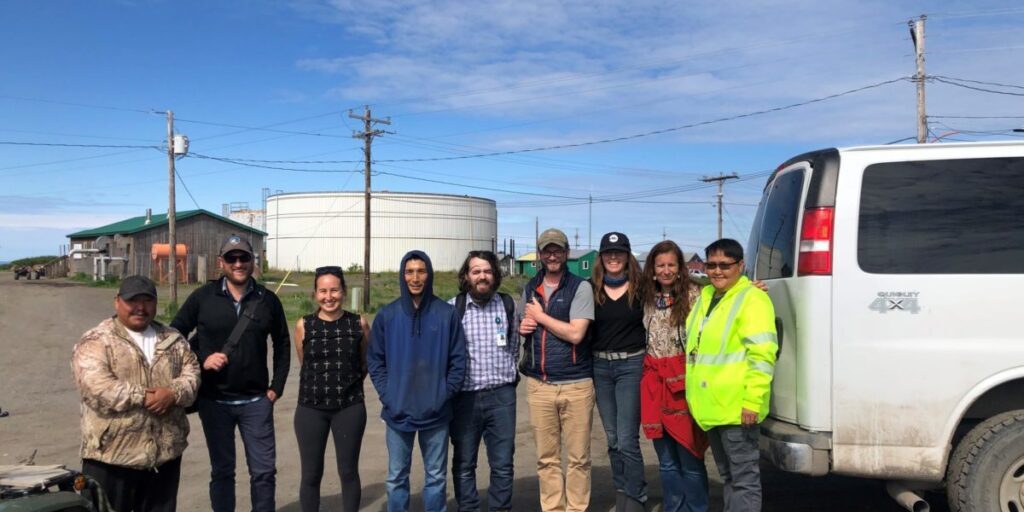Millions of dollars are being awarded to improve water, sanitation, and hygiene (WASH) in rural Alaska.
Lack of water and sewer systems in rural Alaska has been a pressing issue for decades. According to NSHC CEO Angie Gorn, in the Norton Sound Region alone, 370 homes do not have potable water, and over 450 homes have neither water nor sewer. Numerous communities – including Wales, Stebbins, Shishmaref, Teller, and Diomede – lack a safe water supply and sewage disposal system.
Valerie Nurr’araaluk Davidson, president of the Alaska Native Tribal Health Consortium, says that the COVID-19 health crisis shined a spotlight on the need to have clean water across rural Alaska.
“Over the last year, what have we heard constantly? To protect you and your family, you need to do three things: you need to wash your hands constantly; you need to clean surfaces, and be careful of what you’re touching; and you need to maintain distance from another person. Imagine how heartbreaking it is to be a person who lives in a rural community and know that because you don’t have basic running water in your community, in your home, two out of three of those things are impossible for you to do.”
– Valerie Nurr’araaluk Davidson
The Leona M. and Harry B. Helmsley Charitable Trust announced last week a $20,434,374 grant for Engineering Ministries International (EMI) to improve water and sanitation in 134 communities around the state – including 15 in Western Alaska.
Norton Sound Health Corporation’s Board Chair Preston Rookok shared that this grant is a large step toward providing help for communities that continue to struggle with maintaining water and sewer systems in the region.
“Our city governments have a very tough job. They have to keep the system running smoothly in rural Alaska with the harshest weather conditions, with shoestring budgets. We want them to know they are not alone. The co-op will provide and support and we will move forward together.”
– Preston Rookok
A large portion of the grant will also be used to help NSHC establish the Tribal Community Assistance Program. This co-op that Rookok was referring to, will help manage utilities in rural communities and provide competitive salaries and benefits to local water operators. NSHC CEO Angie Gorn announced the program at a press conference for the grant last week.
“This concept of a tribal community utility assistance program, a co-op, had been under consideration for quite some time. But this opportunity really was the catalyst for us to stop and say why aren’t we doing this today?”
– Angie Gorn
NSHC is also pledging to give $500,000 annually from that same grant as a subsidy to Norton Sound communities for their water and sewer budgets.
Other goals for the funds include cross training current utility workers, as well as lowering homeowner bills for water and sewer in the Norton Sound.
EMI WASH Project Manager Jason Chandler has been visiting Norton Sound communities with a small engineering team to begin project assessments. He says three-quarters of the $20-million grant will be used to improve existing water and sewer systems in the 15 villages in the Norton Sound Region.
Chandler explains that a big idea of the project is to boost Best Practice Scores for regional communities and ultimately help them be more eligible for funding.
“This year, there were no funded [WASH] projects within the region. And a lot of that’s due to the best practice scores. So [the project will help] the Norton Sound Region, all of the communities, get their best practice scores up and provide the assistance they need to do that. Currently, it’s hard for these communities to do on their own. And so by providing that assistance, you’re able to help make it eligible for more funding to come in. And so that’s benefitting all of the communities.”
– Jason Chandler
Best Practice Scores are criteria used by the Indian Health Service and the EPA to determine eligibility for water and sewer projects. If a village project does not meet the financial, technical, and managerial criteria listed on the federal entities’ rubric, then it might not get the needed funds.
Despite the three-year grant being worth $20 million, it’s nowhere near enough to solve the Norton Sound’s water and sewer issues. A single project can cost millions of dollars. But Chandler emphasizes that this grant is one way to help cut through some red tape, gather more funding, and continue projects that have already begun.
“You know, in three years when this grant is over, I don’t expect that every community will be completely served and no more issues. But at the same time, I hope that it catalyzes something within the region, within the communities, and within the community of other funders, and federal funders, that it’s bringing in more attention to the need, and it is getting it done.”
EMI will begin installing monitoring systems across the state this summer, and they hope to complete engineering and financial assessments for Norton Sound communities by the end of 2021. Community and household water and sewer projects will begin after the assessments are completed and will be finished by the end of the grant period in 2023.
Image at top: Representatives from NSHC and EMI pose for a photo with water and sewer and maintenance operators in Stebbins. Photo used with permission from NSHC.




